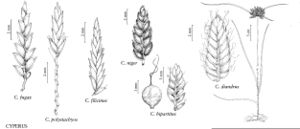Difference between revisions of "Cyperus seslerioides"
in A. von Humboldt et al., Nov. Gen. Sp. 1: 209. 1816.
FNA>Volume Importer |
FNA>Volume Importer |
||
| Line 31: | Line 31: | ||
-->{{#Taxon: | -->{{#Taxon: | ||
name=Cyperus seslerioides | name=Cyperus seslerioides | ||
| − | |||
|authority=Kunth in A. von Humboldt et al. | |authority=Kunth in A. von Humboldt et al. | ||
|rank=species | |rank=species | ||
| Line 46: | Line 45: | ||
|publication year=1816 | |publication year=1816 | ||
|special status= | |special status= | ||
| − | |source xml=https://jpend@bitbucket.org/aafc-mbb/fna-data-curation.git/src/ | + | |source xml=https://jpend@bitbucket.org/aafc-mbb/fna-data-curation.git/src/f50eec43f223ca0e34566be0b046453a0960e173/coarse_grained_fna_xml/V23/V23_246.xml |
|genus=Cyperus | |genus=Cyperus | ||
|subgenus=Cyperus subg. Pycnostachys | |subgenus=Cyperus subg. Pycnostachys | ||
Revision as of 20:06, 16 December 2019
Herbs, perennial, cespitose; rhizomes knotty, much branched, 2–5 mm diam., scaly. Culms roundly trigonous, basally with dark fibrous remnants of old leaf sheaths, (0.5–)4–30 cm × 0.4 –1.1 mm, glabrous. Leaves 1–5, flat, involute toward apex, 3–18 cm × 1–2.5(–3) mm. Inflorescences: heads hemispheric to spheric, (3–)6–15(–24) mm diam.; rays absent; bracts 2–5, horizontal to reflexed, parallel to culm, 1–13 cm × 1–3 mm, margins and keel sparsely minutely scabridulous distally. Spikelets (5–)20–60(–100), whitish to greenish or brownish, ovoid to oblong-lanceoloid, compressed, 3–7 × 2–4 mm; floral scales (8–)10–12(–24), laterally milky white (infrequently yellowish, pale greenish, brown, or bronze-white), medially green or white, laterally ribless, medially 3-ribbed, ovate to ovate-lanceolate, 1.6–3(–3.4) × 0.8–1.3 mm, apex mucronate to acuminate. Flowers: stamens 3; anthers linear, (0.4–)0.6–0.8(–1.1) mm, connective not prolonged; styles 0.8–1.8 mm; stigmas (0.5–)1–1.5(–2) mm. Achenes brown to blackish, trigonous, broadly obovoid, 0.5–1 × 0.3–0.75 mm, base slightly stipelike, ± cuneate to rounded, apex apiculate, papillose.
Phenology: Fruiting summer.
Habitat: Seeps, damp meadows in montane forests
Elevation: 1000–2000 m
Distribution

Ariz., Tex., Mexico, Central America (Honduras), South America.
Discussion
Selected References
None.
